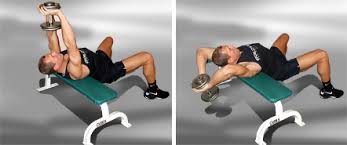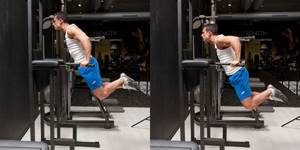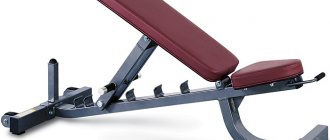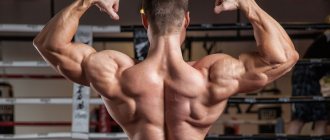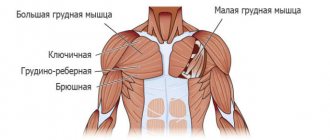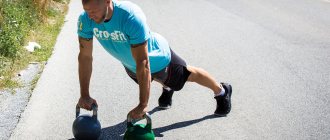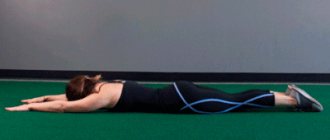How to quickly pump up your pectoral muscles: basic rules and effective exercises
Rules for pumping up the chest muscles
Exercises for the pectoral muscles
Working out the pectoral muscles is a complex, lengthy and labor-intensive process. It requires a lot of effort, working up a sweat and full concentration. However, everything is not so scary and difficult if you follow the basic rules of pumping, perform suitable exercises correctly and regularly, and also monitor your diet and lifestyle.
When starting to work on the chest, it is important to become familiar with the anatomical structure of this part of the body. It includes three main muscle groups that should be given attention during training: the pectoralis major and minor, and the serratus.
Rules for pumping chest muscles
Every athlete is familiar with the basic principles of training and building high-quality muscles. The main rule is regular intensive exercise aimed at working out the desired muscle fiber groups.
When starting work, it is important to correctly draw up a program, schedule and identify exercises that will help achieve the desired result. A trainer can help with this, even if you are going to practice at home.
Training should be carried out 3-4 times a week (for beginners no more than 2), performing several exercises aimed at the serratus, major and minor muscles of the chest. Remember about the mandatory warm-up, which prepares the body for more intense and serious loads. During the main lesson, make sure you perform the exercise correctly, breathe and take into account your sensations.
The number of approaches and repetitions depends on the physical fitness of the athlete and other subjective factors. However, it is worth remembering that in order to progress, you should periodically increase the intensity and duration of the training process, as well as increase the working weight.
An important component of pumping up the pectoral muscles is proper nutrition, which should include high-quality protein and a sufficient amount of nutrients that support anabolism, energy potential and the functioning of the immune system. The menu must include fresh fruits and vegetables, dairy and fermented milk products, fish, meat and cereals. Remember to maintain fluid balance, because during training the body loses a lot of fluid, which can lead to dehydration and other negative consequences.
Do not forget about full recovery (night sleep, weekends) and rest between sets and repetitions. A short break will allow the muscles to rest and recover a little, gaining strength to perform another exercise and get better results. The peculiarity of the pectoral muscles is that they are susceptible to microtrauma and their recovery takes time, so novice athletes should take breaks of 2-3 days between trainings.
Exercises for the pectoral muscles
Many athletes are concerned about the question: is it possible to pump up the pectoral muscles at home? Of course, achieving the desired result and maximum effect in the gym will be much easier. This is due to the constant help and support of a trainer who will help you choose an effective program and adjust it as needed. In addition, a wide range of sports equipment and exercise equipment allows you to change the load and work each muscle group more separately.
However, if you do not have the opportunity to go to the gym, but have a desire to form an ideal body and you can organize yourself at home, you will get the desired result. What exercises will help pump up your pectoral muscles at home?
Push-ups in its various variations are perfect for home training. It perfectly works all the pectoral muscles, and also additionally includes the arms and back in the work.
- Classic. Place your palms on the floor, placing them as wide apart as possible. Place your feet on your toes. Keep your body straight and extended in one line. As you exhale, bend your elbows and lower your body down, while inhaling, return to the starting position (IP).
- Narrow push-ups. The principle of execution is similar to the previous version, the only distinctive feature is that the hands are placed inside so that the fingers touch.
- Push-ups on books. Place two stacks of books up to 40-50 cm high, shoulder width apart, and place your hands on them. Push-ups are performed as in the classic version, but by increasing the deflection of the body, the load on the pectoral muscles increases.
- Leaning forward. Place your feet on a raised surface (bench, sofa, stool), and place your palms on the floor. Perform push-ups from this position. To increase the load and work specifically on the chest, spread your elbows as far as possible to the sides in the lower position.
- With a stop. IP and execution technique as in the classic version. Feature: when going down, stop halfway and hold for 3 seconds, and then lower to the bottom position and stop again.
- Explosive. Take the starting position, focusing on your palms and toes. Slowly lower yourself down, bending your arms at the elbows, and then sharply push off the floor, make a clap and return to the original position. This activity requires some physical preparation, so it should not be included immediately in the program.
On the subject: How to flex the pectoral muscles of a man
An exercise with dumbbells can help in pumping up the pectoral muscles. Lie with your back on the floor or other flat surface with your knees bent. Grab the dumbbells with your hands and extend your arms straight up. As you exhale, slowly spread your arms to the sides, lowering them to the floor, and then return to the starting position. Perform all movements smoothly and slowly, without jerking. If you have a sports bench or bench, you can perform exercises on them - this will increase the range of motion and allow you to achieve maximum results.
Pumping up the pectoral muscles requires great desire, maximum concentration and endurance, as well as full recovery. Following the exercise technique, eating foods rich in protein, and constantly increasing the load will bring the expected results in a short time.
Source
The best exercises to build strong pectoral muscles
Below we describe methods and methods of how to properly pump up the pectoral muscles for a man, but the system is also perfect for girls. But remember that for women this group is much smaller and it will not be possible to increase the size. But you can tighten your skin, remove fat in the armpits and improve your overall appearance if you pump your chest regularly. In one or two short sessions you will not be able to achieve any tangible results.
Do push-ups
This basic movement is often overlooked, although it targets the shoulders and upper chest muscles. Lie face down on the floor with your hands shoulder-width apart and your legs fully straight. Push off the floor with your hands, lift your torso with straight arms. Then lower yourself until your arms are bent at the elbows at a right angle.
If suddenly you don’t know how yet, then here you will learn how to learn how to do push-ups from scratch. And just in case, here are some types of push-ups to add variety to your workout.
- Perform 3 sets of 15 push-ups or as many as you can. Add more reps as your strength increases.
- Push-ups also work the triceps and shoulders (deltoids).
- Try this variation: Place your feet on a step or bench before performing push-ups. This will put a lot of stress on the muscles of the shoulders and chest.
Bench press
This is one of the most popular exercises in the gym for the chest muscles and for good reason. Prepare the barbell according to your capabilities. Remember that it is easiest to start with a light weight and then gradually load the barbell in order to avoid injury at the initial stage. Lie down on a bench with your feet on the floor. Lower the barbell under control and lift it above your chest in one motion.
- You can perform this exercise on an incline bench. The technique of performing the exercise is the same, only with a regular bench press, more muscles of the upper chest work, and on an inclined surface the load is directed to the lower part of these muscles. Many people do not do this variation of the exercise, but it is necessary to maintain sculpted and beautiful pecs.
Do triceps push-ups
Stand with your back to the bars with a wide grip, place your hands on the bars. Push up on your hands and slowly lower down, tuck your legs. At the beginning, it may be difficult to maintain body weight. But this type of exercise is considered the most effective because the chest muscles are pumped quite quickly.
4. Give each side individual attention
Get into a push-up position and perform a full push-up. Hold the position for 3 seconds, then shift your entire body weight to your right arm and leg. Raise your left arm and leg up and assume a pose similar to the Jumping Jack exercise. Hold the pose for 3 seconds. Shift your weight to your left arm and leg. Hold the position for 3 seconds.
Exercises to effectively pump up your breasts
Before determining how to properly pump up the pectoral muscles, it is necessary to highlight several of the most effective exercises. They can be divided into two groups:
- Presses. They can be performed with a barbell, dumbbells or on machines.
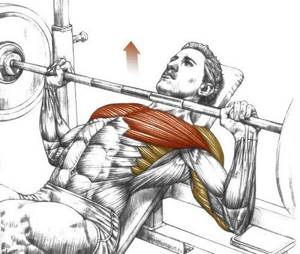
Technology for performing incline barbell presses
- Dilutions. Performed using dumbbells and a crossover.
The nuances of performing incline bench presses
Of all the exercises that allow you to pump up your chest muscles, the incline bench press is one of the defining ones. To perform it correctly, the following technical nuances must be observed:
- The angle of the incline bench should be 30 degrees. This position will allow you to work the upper pectoral muscles, while minimizing the participation of deltoids and triceps.
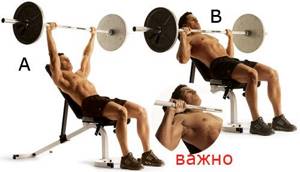
The angle of the incline bench should be 30 degrees.
Important! If you make a sharper angle, then part of the load on the pectoral muscles will be stolen by the deltoids and triceps. In a horizontal position, the lower chest will be involved in active work, which is why the upper part will be unused.
- It is necessary to ensure the correct grip, which should be slightly narrower than average. In this position, the range of motion will be greatest, which will make it possible to use the upper pectoral muscles in the work.
- Movements should be performed within the amplitude, that is, without fully extending the elbow joint. This will eliminate the participation of the triceps, providing the pectoral muscles with maximum contraction during the entire exercise.
Advice! Beginners are recommended to perform 20–30 repetitions. For experienced lifters, the number of repetitions can be reduced to 10-12 in favor of increasing the weight of the barbell.
Technique for performing dumbbell flyes while lying down

Correct execution of dumbbell flyes on a horizontal bench
The necessary load on the correct drawing of the pectoral muscles is provided when performing dumbbell flyes while lying down. Let's consider the technique of performing this exercise.
- Sit on the bench so that your pelvis is located as close to its edge as possible.
- Take the dumbbells in your hands, placing them on your knees. The bar of each dumbbell should be perpendicular to the floor.
- Lean back on the bench, raising your knees bent.
- Feet should not be placed on the floor. It is necessary to leave them bent, while placing your feet on the edge of the bench, which will allow you to avoid involuntary arching in the lower back.
Advice! When performing this exercise, be sure to pay attention to the position of the lower back. Even a slight deflection can remove part of the load from the pectoral muscles, transferring it to the lower back. In this case, the effectiveness of the exercise will decrease.
- Raise your arms so that your hands are positioned clearly above your shoulders. The arms should not be straight - there should be a slight bend in the elbows.
- Now you should spread your arms as far as possible. At the lowest point you will clearly feel discomfort.
We also recommend that you pay attention to the article: Push-ups for the upper and lower pectoral muscles.
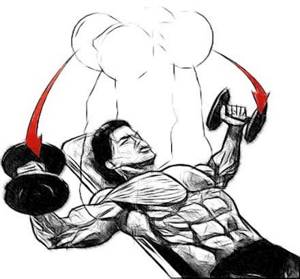
Trajectory of arm movement when performing dumbbell flyes correctly
Important! When performing this exercise, you should not experience pain, as this can lead to muscle injuries.
- Slowly bring your arms together until the dumbbells touch each other. At the top point, the dumbbells should be in contact with slight pressure, which will provide additional impact on the muscles.
We also recommend studying this topic:
Chest exercises at home: tips and complex
11429 0 1
A set of exercises for developing the pectoral muscles
In order to properly pump up your chest muscles, you need to use the right training complex. Consider one of the most productive exercise programs:
- Bench press on an incline bench. Perform 4 sets of 10-12 repetitions each.
- Dumbbell flyes - 3 sets of 10-15 repetitions.
- Incline dumbbell press - 4 sets of 10-12 sets.
This video tells and shows how to properly pump up the pectoral muscles.
Advice! Beginners can exclude the fly from their training program. Experienced athletes need to change the angle of the bench when performing flyes. For example, if today an exercise was performed on an incline bench, then during the next workout it should be performed on a horizontal bench.
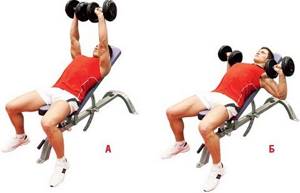
Performing an incline dumbbell press
This material will be perfectly complemented by the following publications:
- How to pump up your chest on the uneven bars: a set of effective techniques
- Chest training program: split programs from professionals
What should you keep in mind when gaining weight?

Avoid overtraining
Many people make one big mistake: they lift weights every day, naively believing that the more they train, the bigger their muscles will become. This actually interferes with muscle growth because it grows during the rest days when the tissue is repairing itself. To avoid overtraining, you need to follow a few simple tips:
- You can train your pectoral muscles no more than 1-2 times a week. In between, you need to pump other muscle groups, such as legs, arms and back.
- Training should not last more than 30-45 minutes, which can cause a spike in cortisol, which destroys muscle fibers and this will lead to regression in increasing muscle size and strength development.
Train to the max
During training, you need to try to put all your strength into the process. Challenge yourself and try to do as much as you can without risking injury to your muscles, ligaments and joints. To find out how much weight you can lift, try performing repetitions with different weights. Try to perform 8-10 repetitions without removing the main weight so that by the end of the set you are sweating and breathing quickly.
- If you can’t perform more than 5 repetitions, then you need to reduce the weight. As you develop strength, start adding more.
- If you can perform more than 10 repetitions without feeling a burning sensation in your muscles, then you need to increase the weight to challenge your endurance.
Follow the correct technique
It is better, of course, that you have a personal trainer or instructor who explains and shows you how to properly perform this or that exercise. To perform each exercise, you need to use muscle strength, not impulse. And achieve a good mental connection between brain and muscle, that is, you should feel the work of the group you want to pump up.
- Improper exercise technique can lead to injuries to muscles, tendons and ligaments, so never forget how to perform the exercise.
- If you cannot perform a movement with a certain weight, then the weight needs to be removed. For example, if you can't straighten your arms fully when doing chest presses on a bench, simply lose the extra pounds.
On the subject: Fat does not leave the pectoral muscles
"Drying"
It is necessary to train your chest even when you are trying to burn subcutaneous fat. But getting rid of excess weight is not a matter of a training program, but a matter of dieting for weight loss. In this case, a sports diet would be the most appropriate; as for the pectoral muscles during this period, the training program should be aimed at preserving muscles, and not at getting rid of fat, and it is even more pointless to try to pump up the chest.
Forget about aerobic exercise! If you do not take anabolic steroids, you will simply “burn” all your muscles. On the contrary, you should train with heavy training weights. It is best to do the bench press for 6-8 reps. Otherwise, in conditions of calorie deficit, the body will use muscle rather than fat as energy. Muscles are full of glycogen, so if you don’t force your body to think that muscles are vital to it, then it will “eat” them first.
Build muscles
4 week training program
Follow this 4-week program, paying attention to the volume and intensity of your training to meet your target. In the first week of classes, there is a general development of strength and mass of the chest muscles. Further, at weeks 2, 3 and 4, the work is aimed at the middle, lower and upper parts of the muscles, respectively. Although each week includes working on a different area of the chest, the program also includes exercises for all parts of the chest.
In addition to this, we have added several techniques to increase the intensity of the workout. Stick to the plan, add one of the techniques to increase intensity on the last set and if there is an * symbol.
Techniques for increasing exercise intensity
Weight loss
After completing a set with maximum weight, remove the weight from both sides of the barbell or select lighter dumbbells. Continue performing reps to the limit, then remove more weight and do even more reps.
Forced replays
Ask a partner to help you with reps at the end of the set, when the muscles are at their most tired. It should help you lift the barbell precisely so that you overcome the moment when lifting becomes difficult.
Partial repeats
Perform repetitions only within a certain range—at the top, middle, or bottom—of the movement.
Pauses
During one set of a particular exercise, pause briefly to perform more repetitions. Lift the weight 2-3 times, pause for 20 seconds, then do another 2-3 repetitions. Rest again, then perform as many repetitions as possible and repeat again.
Negative repetitions
Slow down as your arms lower down with the barbell. For example, when bench pressing, use a weight that is 15% to 25% heavier than normal and slowly lower the barbell down toward your chest. Let your partner help lift the barbell up.
Week 1: for general chest muscle development
| Exercises | Picture | Sets and reps |
| 1. BENCH PRESS Equipment: barbell, bench Perform as a warm-up, in 3 sets if possible. | 2 x 15-20 pause | |
| 2. BENCH PRESS Equipment: barbell, bench * + 1 technique to increase intensity on the last set | 3 x 6-8* pause | |
| 3. BAR PRESS ON AN INCLINED BENCH Equipment: barbell, incline bench | 3 x 8-10 pause | |
| 4. DUMBBELL FLIES ON AN INCLINED BENCH Equipment: dumbbells, incline bench | 3 x 10-12 pause | |
| 5. BENCH PRESS ON A SMITH MACHINE Equipment: Smith machine | 3 x 12-15 pause | |
| 6. Push-ups | 3 x maximum pause |
Week 2: Midsection Exercises
1. BENCH PRESS
Equipment: barbell, bench
Perform as a warm-up, in 3 sets if possible.
| Exercises | Picture | Sets and reps |
| 2 x 15-20 rest | ||
| 2. DUMBELL PRESS Equipment: dumbbells, bench | 3 x 8-10 rest | |
| 3. Bent-over rows on the “CROSSOVER” MACHINE * + 1 technique to increase intensity on the last approach | 3 x 6-8* pause | |
| 4. “PULLOVER” WITH DUMBBELL Equipment: bench, dumbbell |
| 3 x 8-10 pause |
| 5. INCLINE DUMBBELL PRESS Equipment: incline bench, dumbbells * + 1 technique to increase intensity on the last set | 3 x 10-12* rest | |
| 6. Push-ups | 3 x maximum rest |
Week 3: Upper Exercises
6. STEP PUSH-UPS
Equipment: step
| Exercises | Picture | Sets and reps |
| 1. INCLINE BAR PRESS Equipment: barbell, incline bench Perform as a warm-up, in 3 sets if possible. | 2 x 12-20 pause | |
| 2. INCLINE BAR PRESS Equipment: barbell, incline bench * + 1 technique to increase intensity on the last set | 3 x 6-8* pause | |
| 3. DUMBELL PRESS Equipment: dumbbells, bench | 3 x 8-10 pause | |
| 4. STANDING CROSSOVER * + 1 technique to increase intensity on the last approach | 3 x 10-12* pause | |
| 5. DUMBBELL FLIES ON AN INCLINED BENCH Equipment: dumbbells, incline bench | 3 x 15-20 break | |
| 3 x maximum break |
Week 4: Lower Exercises
| Exercises | Picture | Sets and reps |
| 1. INCLINE BAR PRESS Equipment: barbell, incline bench Perform as a warm-up, in 3 sets if possible. | 2 x 12-20 rest | |
| 2. INCLINE BAR PRESS Equipment: barbell, incline bench | 3 x 6-8 rest | |
| 3. STANDING BLOCK PULL ON THE CROSSOVER MACHINE * + 1 technique to increase intensity on the last approach | 3 x 8-10* rest | |
| 4. BENCH PRESS Equipment: barbell, bench | 3 x 10-12 rest | |
| 5. TRICEPS PUSH-UPS Equipment : parallel bars |
| 3 x maximum rest |
Nutrition for muscle growth
We have already figured out how to properly pump up our breasts, it’s time to decide on nutrition so that they grow well and training gives visible results as quickly as possible.

Don't eat too many calories
It is naive to believe that the more calories you consume, the larger and stronger your muscles will be. Calories are needed for energy, which will be needed during training. And if the caloric intake is too high, then the body will increase fat reserves rather than muscle. You need to maintain your optimal energy balance with a slight surplus of 500 calories so that your muscles get enough energy to grow and your pecs look more prominent.
- Do not eat foods with empty carbohydrates (pasta, white bread, cakes, cookies and other baked goods). Choose whole grains.
- Avoid eating too many processed or fried foods and limit fast foods and snacks.

Eat plenty of protein
Protein is the building blocks of muscle fibers, so you need to consume enough protein foods to have large, strong chest muscles. Protein is found in many foods, not just meat. Here are some of the protein sources:
- Lean meat (chicken, fish, lean beef and pork);
- Eggs and dairy products;
- Nuts and beans;
- Cabbage, spinach and other vegetables with protein;
- Tofu and soy.
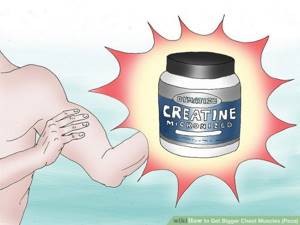
3. Consider taking supplements
Very often, people, along with training and proper nutrition, often take creatine monohydrate, which is a powdered supplement that must be dissolved in water and drunk 3 or more times a day.
- You can try protein shakes. They are one of the most useful supplements for muscle growth and for maintaining overall physical fitness.
FAQ
Perform push-ups, bench presses and dumbbells, working to the maximum in each exercise. Train twice a week with two days between visits to the gym for 8 weeks. If the amount of protein you get from food is not enough, take supplements before and after your workout. Keep your body mass index below 24 to prevent muscles from hiding under fat folds.
2. What should you eat?
Adequate protein intake (20% of total calories) will help provide the body with enough of the right nutrients to gain muscle mass.
3. What type of exercise is the most effective?
In order for muscles to grow, they need to be stressed by increasing the load, which is more easily achieved through strength training with weights. Basically, these are basic multi-joint movements in which several joints are involved. Dumbbell and barbell presses on a horizontal bench and lying at an angle of 30-45 degrees are considered the best exercises for gaining mass in the pectoral muscles. But you can practice by performing different movements with your own body weight. It is also worth performing other basic movements to stimulate testosterone production and protein synthesis in the body.
5. What type of push-ups is best for this?
Any type of push-up will provide additional growth stimulation if done correctly.
6. I'm just doing push-ups. Will I pump up my arms and chest?
Push-ups are aimed at working the immediate pectoral muscles, triceps, shoulders, back if done correctly, and even a little core muscle. But to pump up your chest at home, just exercises with your own weight are not enough, so you need to include exercises with weights in your training program. For your arms, push-ups on your fingertips are more suitable.
7. Is it possible to pump up your breasts only with the help of a proper diet?
This is impossible. A diet will not only gain muscle mass in one specific area of the body.
8. Do I need to do push-ups every day?
Yes, you can do push-ups every day.
9. Is it possible to train every day?
Depends on the type of training. Most people exercise mainly 3-4 times a week. Some advise 6 days of training and one day of rest. If you do low sets and high reps, then this approach will be ideal. Just don't overtrain one part of the body, spend time on other parts of the body.
10. How can I make my muscles more prominent?
Train different muscle groups every day. Prepare a plan for 6-7 days so that each day you focus on a specific part of the body. Let's say on Monday you train for the chest muscles, on Tuesday for the triceps, then for the shoulders, biceps, lateral muscles, thighs, abs, and so on. Repeat this cycle week after week, which will give your muscles definition and volume. After each intense workout, give your muscles up to 24 hours to recover and grow.
Adviсe:
- During exercise, remember that the body must receive vitamins. So eat more fruits, vegetables and grains (a little). Try to get sugar only from fruits.
- Warm up before starting your workout.
- Watch the amount of calories you consume; you should not starve either.
- Try to consume food at the same time, without skipping meals.
- Concentrate on the movement, if you do not feel tension in the muscles (shaking), then you are doing something wrong or the weight is not enough. Do the exercise slowly. Slow and steady repetitions are better than fast and erratic movements.
- Go swimming. This is a great way to develop your upper torso muscles.
- Don't stop exercising just because you don't see results after a week.
- Drink plenty of water.
- Listen to music while exercising.
- Don't feel sorry for yourself.
- It is better to pump one muscle group once every 3-4 days or until the discomfort goes away. That is, you pump your chest, 1 day of rest, then you work on, for example, your arms or legs, a day of rest, and you can return to the chest again.
- Vegetarians should eat more protein. Soy products contain large amounts of protein.
- Try to get enough sleep. Muscles need to rest in order to grow.
- Perform the movements correctly. If everything works out, you can add additional weight.
- Consume 0.8 - 1 kg of protein per kilogram of body weight. Get it with meat, milk, chicken, beans, fish and eggs.
Pump up your chest
Oddly enough, not only girls, but also men want to pump up their breasts The principles of training are directly opposite, this applies to all muscle groups, but especially in this case. If women focus on the upper bundle of pectoral muscles and stretching exercises, then men increase the mass of the lower bundle of pectoral muscles, but first things first.
The pectoral muscles are a large muscle group, which is conventionally divided into three parts: the upper pectoral muscles, the lower chest and the middle of the chest. This is important to know in order to pump up your breasts. The lower part of the pectoral muscles is the most developed genetically, therefore it steals the lion's share of the load.
This happens always and everywhere - a stronger muscle, other things being equal, always takes on more load than weaker muscles. In this way, the body saves energy, and it uses weaker muscles only when a strong muscle can no longer cope with the load.
Therefore, in order to pump up the chest evenly, the athlete has to perform special exercises that force the body to pump those areas of the pectoral muscles that it usually does not strain.
To do this, use an inclined bench, hand position, dumbbells and other tricks.
But training the pectoral muscles varies in its objectives; it can pursue the goal of building muscle mass, adjusting proportions, increasing strength and “drying”. In this regard, the training program will differ.
Pump up your chest: mass
To build muscle mass in the pectoral muscles, you must perform basic exercises, with an emphasis on the target muscles. The first thing here is technology. If, when training strength indicators, you must include many muscle groups, then the situation is exactly the opposite.
You can pump up your chest with three exercises: bench press, angled press, and wide-grip parallel bars with additional weights. In this case, it is necessary to observe microperiodization.
The chest can be pumped twice a week, with training programs aimed at pumping the chest.
It will be best if at the beginning of the week you do the bench press for four working sets of 8 reps, and at the end of the week, two days before your next chest workout, weighted bars and incline presses in the 12 rep range.
Pay attention!
This training scheme will allow you to progress the load, on the one hand, and on the other hand, pump up lagging areas of the pectoral muscles, which will make it possible to evenly pump up your chest.
The leading bundle of the pectorals is the lower chest, the top and middle lag behind. Therefore, the athlete should perform the bench press, which pumps up the bottom, with a barbell, and the angled press with dumbbells.
Weighted bars help to pump up the middle of the chest perfectly.
When training for mass, you must perform the exercise with appropriate technique. During the bench press, your feet should be on the bench, and your elbows should be spread out to the sides so that when the barbell touches your chest, they form an angle of 90°. Using dumbbells while pressing at an angle will allow you to engage the stabilizer muscles, which will help deepen the load.
But you shouldn’t do isolation exercises! Leave this until you get around to adjusting the proportions.
Now remember , we train only with basic exercises, we train the chest twice a week, we don’t try to take more weight than we can, but we monitor the technique and focus the load on the pectoral muscles. Follow these rules, and pumping up your breasts will not be difficult!
Pump up your breasts: quality
Unlike gaining muscle mass, where the athlete is interested in the massiveness of the muscles, in this case they are interested in their shape. There are two reasons why an athlete may wonder about adjusting their proportions: some area of the pecs is lagging behind, or the athlete has a narrow bone structure.
In the first case, either the upper bundle of the pectoral muscles or the middle of the chest may lag behind. Accordingly, it is necessary to do the exercises that can help restore the imbalance. First of all, these are angled presses and weighted parallel bars. But the bench press will have to be excluded. Instead of the bench press, include the head down press and dumbbell flyes in your training program.
You already know the functions that parallel bars and an angle press perform - these exercises allow you to pump up your chest.
Dumbbell flyes allow you to stretch the pectoral muscles and place a good emphasis on the load in the middle of the chest.
It is important!
The upside down press pumps up the bottom of the chest and feet, but just now we were talking about the fact that the bottom of the chest is always in the lead anyway! Right! But this exercise will help to draw the bottom of the pectoral muscles, lifting the chest up.
To expand your core, you will have to devote a separate workout. It is important to note that pumping your breasts in this way only makes sense if your growth zones have not yet closed, which means up to 25 years.
The essence of the training is to expand the chest. To do this, you will need a superset, which consists of squats with a barbell and a pullover.
This workout will not only pump up your chest, but will enhance the effectiveness of all chest muscle training.
Barbell squats should be performed with a light weight in the 20 rep range while breathing deeply. You may even need the pranayama technique, you should inhale as deeply as possible and exhale quickly with effort.
One repetition should take at least 6 seconds. After you do a set of squats, you need to move on to the pullover.
You will also perform the pullover while breathing deeply, doing the exercise for at least 12 repetitions in one approach.
Perhaps, mass training and chest correction can be combined into one system, in which at the beginning you pump up muscle mass, and then correct their shape. It is important to follow the correct technique, which allows you to improve neuroconnection, and the sequence of training.
Helpful advice!
But remember that these are the basic rules for training the pectoral muscles; in order to pump up your chest or other muscle group, you need to choose the right training program that will suit you. After all, you may enter a phase of overtraining, or a plateau, perhaps you have reached your genetic limit, etc.
Interesting: How to pump up your abs on a bench
Therefore, following the basic training recommendations, choose the training program that will be most effective for you at the moment.
Pump up your chest: strength
It is necessary to train the strength of the pectoral muscles by performing basic exercises, but unlike mass training, in a low frequency number of repetitions. We're talking about the bench press.
In this case, the exercise technique will be specific, you will have to make a bridge, bring your shoulder blades together, turn your elbows towards the body, lowering the barbell, you will touch the solar plexus, and your hands will be pressed to the body.
With this technique, most of the load will be received by the triceps, latissimus dorsi, legs and shoulders, which does not really help pump up the chest. But you will be able to lift more weight, which will stimulate your fast-twitch muscle fibers to grow. Often bodybuilders neglect this technique, because this is an exercise for powerlifters, but they do it in vain. The fact is that micro and macro periodization are very useful.
The more varied load you give your muscles, the more effective the workout. The body has to adapt, so you are less likely to hit a plateau.
Since the load is different, the chance of overtraining is also less. Moreover, by increasing strength indicators, you will be able to more easily progress the load when training your chest for weight.
Therefore, it is easier to pump up your chest by training different muscle qualities than to “pound” the same training program.
"Drying"
It is necessary to train your chest even when you are trying to burn subcutaneous fat. But getting rid of excess weight is not a matter of a training program, but a matter of dieting for weight loss.
In this case, a sports diet would be the most appropriate; as for the pectoral muscles during this period, the training program should be aimed at preserving muscles, and not at getting rid of fat, and it is even more pointless to try to pump up the chest.
Forget about aerobic exercise! If you do not take anabolic steroids, you will simply “burn” all your muscles. On the contrary, you should train with heavy training weights. It is best to do the bench press for 6-8 reps.
Otherwise, in conditions of calorie deficit, the body will use muscle rather than fat as energy.
Muscles are full of glycogen, so if you don’t force your body to think that muscles are vital to it, then it will “eat” them first.
Build muscles
Source: https://Fit4Power.ru/shema/nakaceatigrudi
